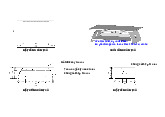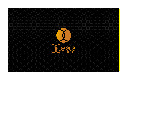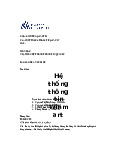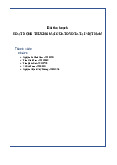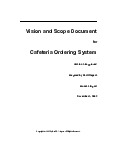



















Preview text:
HOA SEN UNIVERSITY SOFTWARE PROJECT MANAGEMENT Project Plan FAT32 Analyzer Document Control Document Information © Information Document Id #44231 Document Owner Truong Dang Khoa Issue Date 20 May 2024 Last Saved Date 1 June 2024 File Name Project Plan Document History Version Issue Date Changes [1.0]
21 May 2024 Initial draft of the FAT32 Analyzer Project Plan
Updated project timelines, refined resource allocation, [1.1] 1 June 2024
and incorporated initial stakeholder feedback Document Approvals Role Name Signature Date © Project Sponsor 1 June Nguyen Ngoc Tu Tu Nguyen 2024 Project Review Group Project Manager Truong Dang 1 June Khoa 2024 i Revision Document History: Issue Page (P) / Version Description Dept./Init. Date Chapt. (C) 21 Initial draft of the FAT32 Truong 1.0 May All Analyzer Project Plan. Dang Khoa 2024 Updated project timelines, refined 1 June 2, 4, Truong 1.1 resource allocation, and 2024 Appendix Dang Khoa incorporated initial stakeholder feedback. ii Table of Contents
Document Control.............................................................................................................i
Revision............................................................................................................................ii 1.
Overview:..................................................................................................................1
1.1 Introduction...............................................................................................................1
1.2 Bussiness objective..................................................................................................1 2.
Assumptions and Constraints:...............................................................................1
1.3 Current Situation and Problem/Opportunity.............................................................2 3.
Goals and Scope......................................................................................................3 4.
Organization..............................................................................................................5
4.1 Organizational Boundaries and Interfaces...............................................................5
4.1.1 Parent Organization..........................................................................................5
4.1.2 Customer Organization.....................................................................................6
4.1.3 Resource Owners..............................................................................................6
4.1.4 Receivers...........................................................................................................6
4.1.5 Sub-contractors.................................................................................................6
4.1.6 Suppliers............................................................................................................6
4.1.7 Cross Functions................................................................................................6
4.1.8 Related Projects................................................................................................6
4.2 Project Organization.................................................................................................7
4.2.1 Project Manager................................................................................................7
4.2.2 Project-Internal Functions.................................................................................7
4.2.3 Project Team......................................................................................................8
4.2.4 Steering Committee...........................................................................................9
4.2.5 RACI Matrix.....................................................................................................10 5.
Schedule and Budget.............................................................................................11
Work Breakdown Structure (WBS):..............................................................................11
5.1 Tasks......................................................................................................................13
5.2 Effort.......................................................................................................................17
5.3 Dependencies........................................................................................................19
5.4 Schedule and Milestones.......................................................................................21
5.5 Budget....................................................................................................................24
5.6 Project Phases.......................................................................................................28
5.7 Development Environment.....................................................................................29
5.8 Measurements Program.........................................................................................31 6.
Quality Requirements............................................................................................33
6.1 Functional Requirements.......................................................................................33
6.2 Non-Functional Requirements...............................................................................34
6.2.1 Performance....................................................................................................34
6.2.2 Security............................................................................................................34
6.2.3 Usability...........................................................................................................34
6.2.4 Portability.........................................................................................................34
6.2.5 Maintainability..................................................................................................34 7.
Risk Management...................................................................................................35
7.1 Roles & Responsibilities.........................................................................................36
7.2 Risk Estimation.......................................................................................................36 8.
Sub-contract Management....................................................................................36
8.1 Current Status........................................................................................................36
8.2 Rationale................................................................................................................37
8.3 Procedure IF Sub-contracting Becomes Necessary..............................................37
8.4 Sub-contractor Monitoring & Management............................................................38 9.
Communication and Reporting.............................................................................38
9.1 Stakeholder communications reqquirements:........................................................38
9.2. Communications summary:...................................................................................38 9.3
Comments/Guidelines:.......................................................................................39
9.4 Escalation procedures for resolving issues:...........................................................39
9.5 Revision procedures for this document..................................................................39
9.6 Glossary of common terminology:..........................................................................39
10. Delivery Plan............................................................................................................40
10.1 Deliverables and Receivers.................................................................................40
11. Quality Assurance...................................................................................................40
11.1 Quality Management Plan:...................................................................................40
11.1.1 Quality Standards:.........................................................................................41
11.2 Metrics:.................................................................................................................41
11.3 Problem Reporting and Corrective Action Process:.............................................42
11.4 Supplier Quality and Control:...............................................................................42
11.5 Quality Checklist:..................................................................................................43
12. Security Aspects......................................................................................................45
12.1. Information Classification....................................................................................45
12.2. Specific Security Actions.....................................................................................46
12.3. Information Distribution and Publishing..............................................................46
12.4. Security Monitoring..............................................................................................46
12.5. Security Incident Reporting.................................................................................47
13. Abbreviations and Definitions...............................................................................47
14. Appendix..................................................................................................................48
Detailed Project Schedule............................................................................................48 1. Overview: 1.1 Introduction
This project aims to develop a program capable of reading and analyzing information
from FAT32 formatted disks. The program will specifically focus on extracting details
related to data storage on the disk. The File Allocation Table (FAT) is a file system
commonly used on storage devices like USB drives and SD cards. FAT32 is a specific
variant that allows for larger storage capacities compared to its predecessors (FAT16).
By directly accessing and interpreting the FAT32 data structures on the disk, the
program can glean valuable information about how files are organized and stored. 1.2 Bussiness objective
Open-Source Educational Tool:
Develop a freely available tool to promote education and understanding of how
data is stored on FAT32 formatted disks.
Target Audience: Computer science students, IT professionals interested in data
storage fundamentals, and anyone curious about how their storage devices work. Benefits:
Increases public awareness of data storage concepts.
Can be used as a learning resource in educational settings.
Potential for community contributions and further development.
2. Assumptions and Constraints: Assumptions
Technical Knowledge: Using the program effectively might require some basic
understanding of computer storage concepts like sectors, bytes, and file allocation tables.
o Reason: This assumption is about the user’s knowledge level, which
influences design decisions but does not limit the program’s functionality.
Complexity vs Usability: There's a trade-off between offering advanced
features and maintaining a user-friendly interface. The development process will
need to find a balance between functionality and ease of use for the target audience.
o Reason: This is an assumption about the design approach and user
interface decisions, not a hard limit on the program’s capabilities. Constraints: 1
FAT32 Format: The program is designed specifically for FAT32 formatted disks.
Adapting functionalities to other FAT variants (e.g., FAT16) would require extensive modifications.
o Reason: This limits the scope of the program to a specific file system format.
Operating System Compatibility: Initial development might focus on a specific
operating system (e.g., Windows) due to potential differences in disk access
methods across various platforms.
o Reason: This limits the initial development to a single operating system,
constraining the development environment and compatibility.
Performance Considerations: Reading and analyzing raw disk data can be slow,
especially for large disks. The program should be designed to balance functionality with performance.
o Reason: This constraint affects how the program is designed and optimized for performance.
1.3 Current Situation and Problem/Opportunity
Current Situation: Many users rely on tools and software to interact with their storage
devices, which typically present a user-friendly interface for managing files and folders
but often hide the underlying workings of the file system. There's a lack of readily
available software specifically designed for analyzing the low-level details of FAT32
formatted disks. While forensic tools might offer such functionalities, they can be
complex and expensive for casual users.
Problem: Limited accessibility to tools that read and analyze the raw data organization
on FAT32 disks. This makes tasks like data recovery, disk forensics, and understanding
FAT32 file systems more challenging for everyday users.
Opportunity: Develop a user-friendly program that reads and analyzes FAT32 disks,
focusing on aspects like sector size, byte structure, and physical sector locations. This
program can empower users with: Simplified Data Recovery Basic Disk Forensics Educational Tool 2 3. Goals and Scope Project Goals
o Project Goal Priority Matrix: Project Goal Priority Reason for Priority Impact if Not (High/Medium/Low) Achieved Develop a robust High Core deliverable of Project fails to meet FAT32 Analyzer the project primary objectives program Create a High Essential for user Users may struggle comprehensive adoption and to use the program documentation set effective use effectively (knowledge base, user manuals, tutorials) Ensure the FAT32 Medium Enhances user Users may find the Analyzer program is experience and tool difficult to use, user-friendly efficiency reducing its effectiveness Complete the project High Critical for project Project may run out within the budget feasibility and of funds, leading to ($40,000 - $50,000) stakeholder approval delays or incomplete deliverables Finish the project on High Timely delivery is Delays could affect time (by July 31st,
essential for meeting stakeholder trust and 2024) stakeholder project relevance expectations Improve forensic Medium Provides significant Reduced analysis capabilities value to forensic effectiveness of the investigators analyzer tool Enhance data Medium Important for data Data recovery from recovery capabilities recovery specialists FAT32 drives may remain challenging Provide ongoing Low Ensures long-term Users may face maintenance and usability and unresolved issues or support satisfaction bugs Establish a user Low Useful for Future iterations feedback loop for continuous may lack user- future improvements improvement driven enhancements Project Scope a. Inclusions: 3
Key features and functionalities included within the scope of this project: Core System:
Robust FAT32 Parsing Engine: Capable of accurately interpreting all critical file
system data structures, handling file fragmentation, and identifying remnants of deleted files.
Comprehensive File Carving Capabilities: To recover deleted files from
unallocated disk space through signature analysis and content-based reconstruction.
User-Friendly Interface: A Graphical User Interface (GUI) for intuitive interaction
with the analysis features, clear data presentation, and straightforward reporting. Functionalities:
Data Filtering and Search: Powerful search filters based on file names,
extensions, timestamps, and other attributes to expedite forensic investigations.
Analysis Report Generation: Clear and concise reports summarizing key findings from the FAT32 analysis. Supporting Materials:
Comprehensive User Manuals: Providing step-by-step guidance on utilizing the
program's features and conducting various forensic analysis tasks.
Practical Tutorials: Illustrating common investigation scenarios and
demonstrating the use of the FAT32 Analyzer in real-world case examples.
System Architecture Documentation: Detailed technical specifications for future
maintenance, potential expansion, and program enhancements. b. Exclusions:
While the FAT32 Analyzer will be a valuable asset, it's important to define what is not
within the project's scope. This helps to avoid misunderstandings and prevents
unrealistic expectations regarding the tool's capabilities.
The following are explicitly excluded from the project:
Hardware Development or Procurement: The project relies solely on software
development and leverages existing organizational hardware infrastructure.
Integration with External Forensic Tools: Initial versions of the FAT32 Analyzer
will not have direct integrations with other forensic suites. However, data export
in common forensic formats will be available for interoperability. 4
